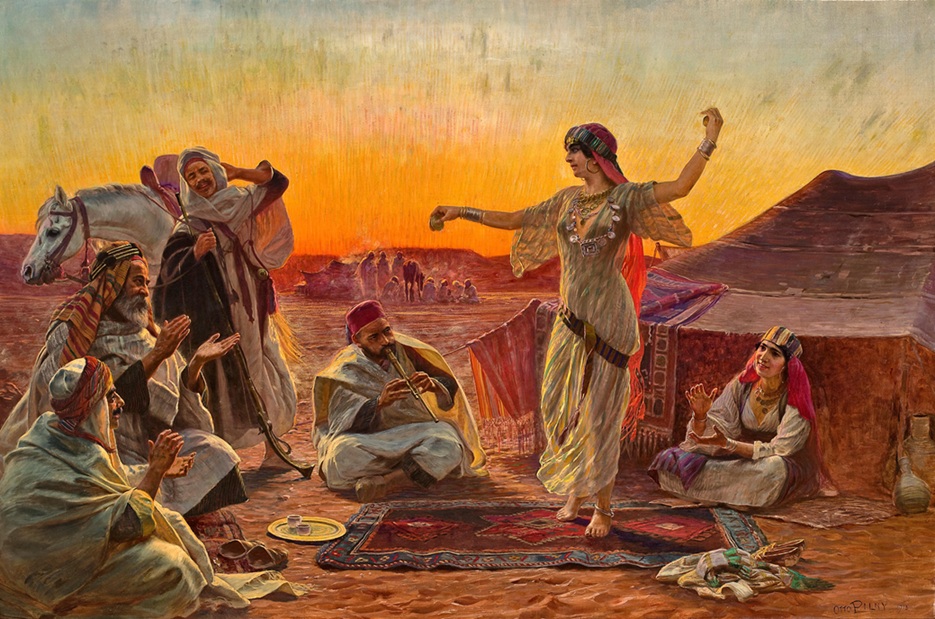Cesare Felix Georges dell' Acqua (ITALIAN, 1821-1904)
Greek mother, c. 1860
Oil on canvas
86 x 66 cm.
Private collection
Sold for £938,400 in December 2007
This painting is an archetypal image of the Greek War of Independence and a classic document in the history of 19th century Philhellenism. As noted by F.M. Tsigakou in her seminal book The Rediscovery of Greece.
Cesare dell Acqua's Greek Mother is a scene full of drama and emotion. Frightened yet fierce, the young mother leaves the spectator in no doubt that no enemy will ever take her child from her arms. Such a scene not only moves the heart but sanctifies the Greek cause, while alluding to a heroic, glorious past.
The war provided European artists with a wealth of themes. Pictorially, the heroic, religious, classical and oriental elements of the Revolution offered them particularly sensational subject matter. Furthermore, the theme was so familiar to the European public that artists utilised it to allude to the oppression in their own countries. More on this painting
The Greek War of Independence, also known as the Greek Revolution of 1821 was a successful war of independence by Greek revolutionaries against the Ottoman Empire between 1821 and 1829. The Greeks were later assisted by the British Empire, France, and Russia, while the Ottomans were aided by their North African vassals, particularly the eyalet of Egypt. The war led to the formation of modern Greece. The revolution is celebrated by Greeks around the world as independence day on 25 March. More on The Greek War of Independence
Cesare Felix Georges dell' Acqua was born in Pirano d'Istria near Trieste in 1821 and died in Brussels in 1904. He entered the Venice Academy in 1842 and studied painting under Ludovico Lipparini, Odorico Politi and Michelangelo Grigoletti. One of his early works, The Meeting of Cimabue and the Young Giotto (1847) was noticed and acquired by Archduke Johann of Austria. In this period he also received commissions from Prince von Lichtenstein. Soon after, the artist continued his studies in Paris and in 1847 he moved to Brussels where his brother Eugène lived. There he became a student of Gallait. Following his studies, he travelled to Vienna, Munich and Paris, along with his patron, the Hungarian Baron Ludovico Luigi Reszan. Soon after, he painted two large pictures for the Greek Orthodox Church of Trieste, one of which, The Sermon of John in the Dessert, was so acclaimed that he was awarded town citizenship in 1851. The other painting, Jesus Calling the Small Children to Him, was shown in the 1854 Brussels Exhibition, where he received the gold medal.
Dell' Acqua always knew how to pick attractive or interesting historical subjects. He also painted watercolours, a large collection of which was in the hands of Countess Duval de Beaulieu in Brussels. Some of his works were acquired by the collection of the Belgian Royal Palace. Besides historical romantic motifs he also painted subjects drawn from daily life. Between 1858 and 1866 he produced a number of large works in the Miramare Palace of Kaiser Maximilian, recounting the long history of the area. Works by Dell' Acqua are included in major private and public collections, such as the museums of Brussels, Antwerp, Trieste and Bruges. Besides this rich output, Dell' Acqua painted many attractive female half-length portraits clad in traditional Greek and oriental garb. More on Cesare Felix Georges dell' Acqua
Please visit my other blogs: Art Collector, Mythology, Marine Art, Portrait of a Lady, The Orientalist, Art of the Nude and The Canals of Venice, Middle East Artists, 365 Saints, 365 Days,
and Biblical Icons,
also visit my Boards on Pinterest and my art
stores at deviantart and Aaroko
Images are copyright of their respective owners, assignees or others.
Some Images may be subject to copyright
I don't own any of these images - credit is always given when due unless
it is unknown to me. if I post your images without your permission, please tell
me.
Ads are shown only to compensate the hosting expenses.
If you enjoyed this post, please share with friends and family.
Thank you for visiting my blog and also for liking its posts and pages.
Please note that the content of this post primarily consists of articles
available from Wikipedia or other free sources online.









